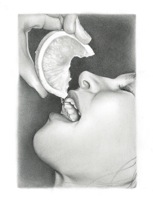Difference between revisions of "Taste"
(Created page with 'File:lighterstill.jpgright|frame ==Etymology== [http://nordan.daynal.org/wiki/index.php?title=English#ca._1100-1500_.09THE_MIDDLE_ENGLISH_PERIOD ...') |
(→Quote) |
||
| Line 13: | Line 13: | ||
'''Taste''' (or, more [[formally]], gustation; adjectival [[form]]: "gustatory") is a form of direct chemoreception and is one of the [[traditional]] five [[senses]]. It refers to the [[ability]] to detect the flavor of substances such as [[food]], certain minerals, and [[poisons]]. In [[humans]] and many other vertebrate [[animals]] the [[sense]] of taste [[partners]] with the less direct sense of [[smell]], in the [[brain]]'s [[perception]] of [[flavor]]. In the West, experts [[traditionally]] identified four taste sensations: sweet, salty, sour, and bitter. In the Eastern hemisphere, piquance (the sensation provided by, among other [[things]], chili peppers) and savoriness (also known as umami) have been traditionally identified as basic tastes as well. More recently, [http://en.wikipedia.org/wiki/Psychophysics psychophysicists] and [[neuroscientists]] have suggested other taste categories (fatty acid taste most prominently, as well as the sensation of metallic and [[water]] tastes, although the latter is commonly disregarded due to the [[phenomenon]] of taste adaptation. Taste is a [[sensory]] [[function]] of the central [[nervous system]]. The receptor [[cells]] for taste in [[humans]] are found on the [[surface]] of the [http://en.wikipedia.org/wiki/Tongue tongue[, along the [http://en.wikipedia.org/wiki/Soft_palate soft palate], and in the epithelium of the [http://en.wikipedia.org/wiki/Pharynx pharynx] and [http://en.wikipedia.org/wiki/Epiglottis epiglottis].[http://en.wikipedia.org/wiki/Taste] | '''Taste''' (or, more [[formally]], gustation; adjectival [[form]]: "gustatory") is a form of direct chemoreception and is one of the [[traditional]] five [[senses]]. It refers to the [[ability]] to detect the flavor of substances such as [[food]], certain minerals, and [[poisons]]. In [[humans]] and many other vertebrate [[animals]] the [[sense]] of taste [[partners]] with the less direct sense of [[smell]], in the [[brain]]'s [[perception]] of [[flavor]]. In the West, experts [[traditionally]] identified four taste sensations: sweet, salty, sour, and bitter. In the Eastern hemisphere, piquance (the sensation provided by, among other [[things]], chili peppers) and savoriness (also known as umami) have been traditionally identified as basic tastes as well. More recently, [http://en.wikipedia.org/wiki/Psychophysics psychophysicists] and [[neuroscientists]] have suggested other taste categories (fatty acid taste most prominently, as well as the sensation of metallic and [[water]] tastes, although the latter is commonly disregarded due to the [[phenomenon]] of taste adaptation. Taste is a [[sensory]] [[function]] of the central [[nervous system]]. The receptor [[cells]] for taste in [[humans]] are found on the [[surface]] of the [http://en.wikipedia.org/wiki/Tongue tongue[, along the [http://en.wikipedia.org/wiki/Soft_palate soft palate], and in the epithelium of the [http://en.wikipedia.org/wiki/Pharynx pharynx] and [http://en.wikipedia.org/wiki/Epiglottis epiglottis].[http://en.wikipedia.org/wiki/Taste] | ||
==Quote== | ==Quote== | ||
| − | + | ''The [[taste]] designers''. And how can you be told of these artists! Faintly I might suggest that they are improvers of [[morontia]] taste, and they also endeavor to increase the [[appreciation]] of [[beauty]] through the sharpening of the [[evolving]] [[spirit]] [[senses]].[http://nordan.daynal.org/wiki/index.php?title=Paper_44_-_The_Celestial_Artisans#44:6._THE_DESIGNERS_AND_EMBELLISHERS] | |
[[Category: Chemistry]] | [[Category: Chemistry]] | ||
[[Category: Biology]] | [[Category: Biology]] | ||
Revision as of 21:54, 2 June 2010
Etymology
Middle English, to touch, test, taste, from Anglo-French taster, from Vulgar Latin *taxitare, frequentative of Latin taxare to touch, feel
- Date: 14th century
Definitions
- 1 : to become acquainted with by experience <has tasted the frustration of defeat>
- 2 : to ascertain the flavor of by taking a little into the mouth
- 3 : to eat or drink especially in small quantities
- 4 : to perceive or recognize as if by the sense of taste
- 5 archaic : appreciate, enjoy
Description
Taste (or, more formally, gustation; adjectival form: "gustatory") is a form of direct chemoreception and is one of the traditional five senses. It refers to the ability to detect the flavor of substances such as food, certain minerals, and poisons. In humans and many other vertebrate animals the sense of taste partners with the less direct sense of smell, in the brain's perception of flavor. In the West, experts traditionally identified four taste sensations: sweet, salty, sour, and bitter. In the Eastern hemisphere, piquance (the sensation provided by, among other things, chili peppers) and savoriness (also known as umami) have been traditionally identified as basic tastes as well. More recently, psychophysicists and neuroscientists have suggested other taste categories (fatty acid taste most prominently, as well as the sensation of metallic and water tastes, although the latter is commonly disregarded due to the phenomenon of taste adaptation. Taste is a sensory function of the central nervous system. The receptor cells for taste in humans are found on the surface of the tongue[, along the [http://en.wikipedia.org/wiki/Soft_palate soft palate, and in the epithelium of the pharynx and epiglottis.[1]
Quote
The taste designers. And how can you be told of these artists! Faintly I might suggest that they are improvers of morontia taste, and they also endeavor to increase the appreciation of beauty through the sharpening of the evolving spirit senses.[2]
